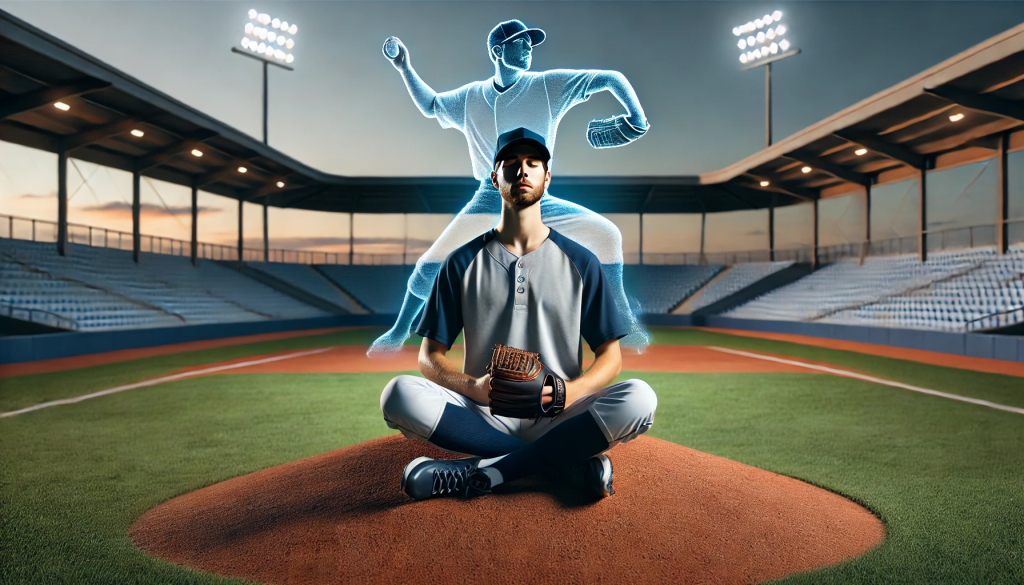Guided Imagery Can Improve Durability and Recovery
Baseball pitchers face unique physical challenges due to the repetitive and high-intensity nature of their movements. Preventing and recovering from injuries is critical to their success and longevity in the sport. Guided imagery—a mental technique involving visualization of scenarios and outcomes—has shown promise in supporting physical recovery and injury prevention. Here’s how guided imagery can help pitchers safeguard their health and return to the mound stronger after injuries.
1. Reinforces Proper Mechanics
Pitching requires precise mechanics, with every element of the motion—from grip to follow-through—impacting performance and health. Poor mechanics can increase the risk of injuries like shoulder impingement, elbow strains, or rotator cuff tears. Guided imagery allows pitchers to mentally rehearse their pitching motion, focusing on correct body alignment, smooth arm paths, and efficient energy transfer. Visualizing these actions not only strengthens neural pathways associated with proper form but also helps pitchers internalize the mechanics needed to minimize strain. By integrating these mental rehearsals with physical practice, pitchers can ensure their movements are safe and sustainable over time, reducing their vulnerability to overuse injuries.
2. Reduces Stress to Promote Physical Health
The connection between stress and injury is often underestimated, but chronic stress can exacerbate physical vulnerabilities. Stress tightens muscles, reduces focus, and hampers coordination, all of which can increase the likelihood of injury. Guided imagery offers a proactive way to manage stress by helping pitchers cultivate a relaxed and focused state of mind. For instance, they can visualize a serene environment or a flawless pitching sequence, which activates the body’s relaxation response. This reduces cortisol levels and relaxes tense muscles, creating optimal conditions for injury prevention. A pitcher who uses guided imagery regularly can approach games and practices with a sense of calm, lowering the risk of injury caused by tension and fatigue.
3. Speeds Up Recovery
Injury recovery can be a frustrating and slow process, but guided imagery provides a way for pitchers to actively participate in their healing. Studies have shown that visualizing the body’s natural recovery processes—such as swelling subsiding, tissue regenerating, and mobility improving—can enhance the effectiveness of physical rehabilitation. For example, a pitcher recovering from an elbow injury might mentally picture the inflammation decreasing, the tendons strengthening, and the joint regaining full function. This visualization doesn’t just boost a pitcher’s morale; it also influences the nervous system, potentially speeding up healing by reducing pain perception and encouraging positive physiological responses. Incorporating guided imagery into daily recovery routines helps pitchers stay motivated and optimistic during their rehabilitation.
4. Maintains Mental Sharpness
For a pitcher sidelined by an injury, staying mentally sharp is essential to making a strong return. Long periods of inactivity can lead to a loss of confidence and a disconnection from the game. Guided imagery helps keep the mind engaged by simulating pitching scenarios in vivid detail. For instance, a pitcher can visualize standing on the mound, assessing the batter, and executing the perfect pitch sequence. These mental exercises stimulate the brain’s motor regions, keeping the pitcher mentally prepared and reinforcing game strategies even while they’re unable to physically practice. By maintaining their mental edge, pitchers can step back onto the mound after recovery with their tactical and strategic skills intact.
5. Builds Confidence for a Strong Return
Returning to the game after an injury often comes with anxiety about reinjury or diminished performance. Guided imagery helps pitchers rebuild their confidence by allowing them to rehearse successful outcomes. They can visualize themselves pitching pain-free, feeling strong, and hitting their targets with precision. This mental preparation reduces fear and promotes a sense of control over their body and performance. For pitchers, confidence is key to overcoming mental barriers and trusting their physical abilities after a setback. Guided imagery can also help them focus on the process rather than the outcome, reinforcing a positive mindset that fosters resilience and long-term success.
Guided imagery is a powerful tool for baseball pitchers to prevent injuries and recover effectively. By reinforcing proper mechanics, reducing stress, promoting healing, maintaining mental engagement, and building confidence, guided imagery addresses both the physical and mental demands of pitching. Incorporating this technique into training and recovery routines can help pitchers protect their health, improve their performance, and return to the game stronger than ever. For athletes aiming for a long and successful career, guided imagery is an invaluable resource.


